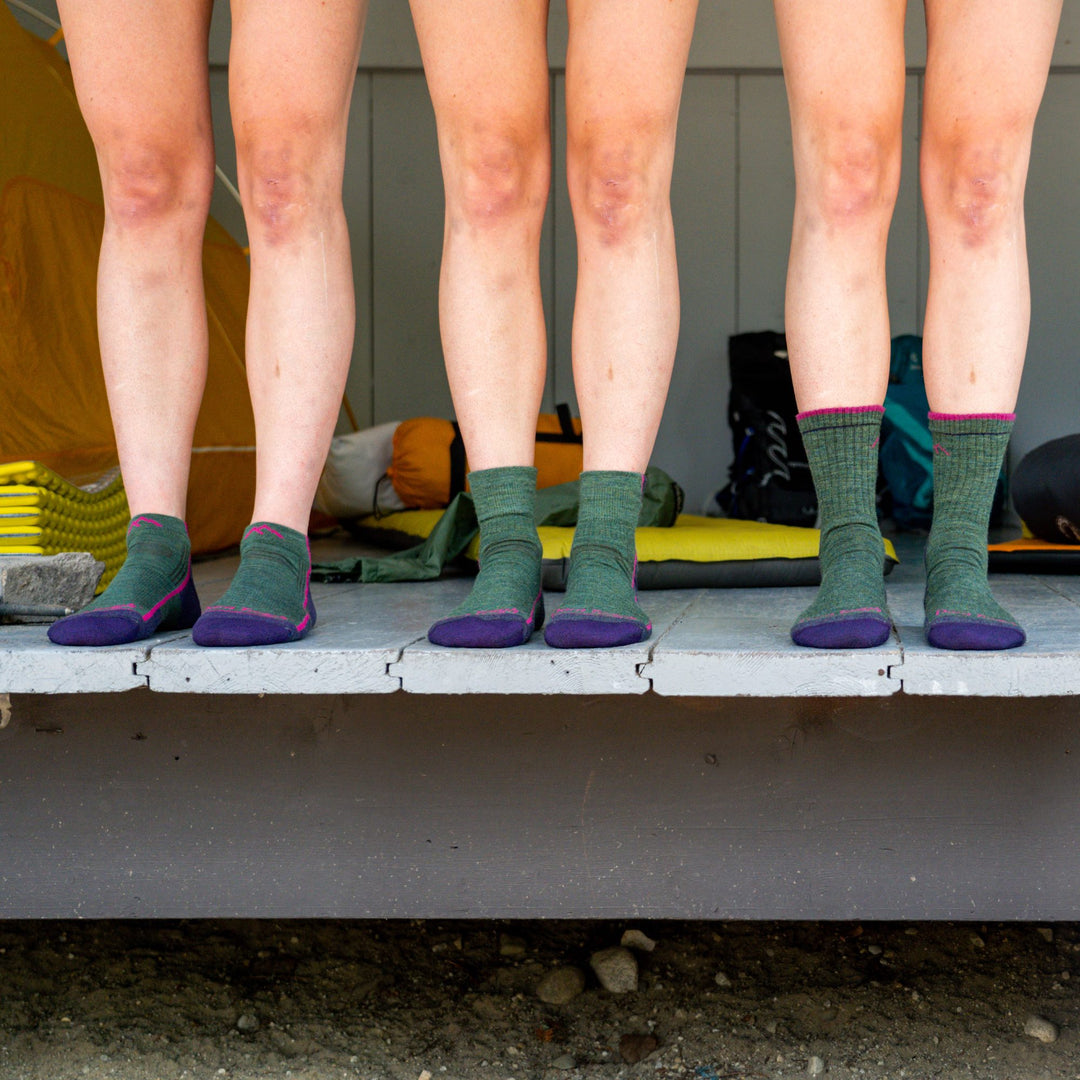Warm in Winter, Cool in Summer. Breathable Socks All Year Round.

At Darn Tough, we have an intimate understanding of just how different the weather can be throughout the year. Swinging between subzero deep freezes in the winter to the sweltering summer humidity, Vermont packs in all four seasons. Plus a few others just for fun.

Makes sense then that our wardrobes change drastically. Who’d be caught outside in a snowstorm wearing shorts? Or running a puffy coat for the fourth of July? Fashion critiques aside, there is a key element to your kit that likely doesn’t change that much: socks. Especially if they’re made from Merino Wool.
How is that possible, when we think having separate climate control for the driver and passengers in cars is some rocket science stuff? There's a reason why wool socks are the best. It turns out sheep have been running their own climate control tech called thermoregulation since, well, sheep became sheep covered in wool. And it doesn’t take a car to turn it on.
Here’s how Darn Tough uses the advantages of Merino Wool to make socks that work in all seasons: warm in the winter, cool in the summer, dry and breathable all the time. If that sounds like a wild sheep chase, read on to find out more.
Take a Deep Breath
Before we define and dive into the heady properties of thermoregulation, we want to point out that Merino Wool is easily the best breathable fabric out there.
No one wants hot feet, and it turns out sheep aren’t a fan of overheating either. Merino Wool naturally pulls evaporating sweat away from your body— keeping air circulating, wicking moisture to keep dampness at bay, and ensuring your feet stay cool when it’s hot out.

Merino is already perfect for making breathable socks, and we take it a step further by designing socks specifically for all sorts of activities. From refining the thickness of the wool (in microns, for any true wool nerds still reading), to adding mesh for even more breathability in key zones, extra cushioning where needed, and of course our legendary fit, you get a sock purpose-built for your demands.
From breathable mesh in our Run socks to extra ventilation in our Hunt socks, we supplement what Merino Wool does so well naturally with the right tech to make lightweight socks for hot weather. Conversely, we know when and where to add cushion in our midweight socks (which also reduces friction) to keep toes warm when it's cold.
Breathability is the start of the behind-the-scenes thermoregulation tech that lets you stay moving, whatever the weather. No doubt sheep didn’t make up that long and technical sounding term, but thermoregulation is the word we use to talk about one of the key benefits of their magical wool.
Thermoregulation and Why It's Awesome
This fancy term is at the heart of why we choose Merino, why you want to have wool socks for winter and wool socks for summer. For a thermoregulation breakdown, we turned to Jenny Knapp, Darn Tough Design Manager and general whiz with all things wool.
“Thermoregulation is how the core body temperature stays balanced at the optimal temperature,” explains Jenny Knapp, Darn Tough Design Manager, “even when the environment around you shifts.” In other words, thermoregulation maintains the best possible temperature for your feet, no matter how cold, or toasty, it gets outside.

Now let’s launch that concept from a laboratory whiteboard to something that anyone getting active can relate to: heating up as you exert more effort. Whether you’re running a marathon or raking up leaves, it’s a given that as we push it physically, our temperature rises.
The body’s response is to turn on its natural AC system, aka sweat. We all know how getting extra hot, then wet and clammy can be straight up uncomfortable. There are actual studies showing how this sudden ramp-up of heat — and the following chill-down when you stop moving — can negatively impact mental, cognitive, and physical performance.
Sort of like a natural superhero come to save the day, Merino Wool’s thermoregulation properties interrupt this cycle by keeping your feet dry and cool.
“Merino Wool is the ultimate performance fiber,” says Knapp. “Merino fibers are highly adaptive, reacting to both the body’s temperature and external environment to create a micro-climate that helps keep the body at that balanced temperature. This buffer created by the Merino fiber will keep the body from chilling in wet, cool weather and from overheating in hot weather.”
How rad is that — Merino Wool is like a natural thermostat, regulating the temperature between your skin and sock for ideal comfort, no matter what the conditions. That means you can stay active, however the weather swings, because you get both cool and warm socks in the same pair.
How It Works
Sheep figured it out over 10,000 years ago. That dual-control climate control in your new car? We’re just catching up on natural evolution. What Merino sheep have going for them is the incredibly complex structure of their wool, with multiple layers all working together simultaneously.

It starts with a natural “crimp” of the wool fiber that create pockets of insulating air, adept at keeping your feet warm and dry in cold weather. Next, there’s the amazingly adaptive wool structure that lets thermoregulation do its thing, dissipating heat when the body warms up and retaining it as you cool down. Knapp explains how it all works together:
“The inner porous core of the fiber absorbs and then releases moisture as vapor depending on body and environmental changes,” says Knapp. “And the outer layer of the fiber buffers skin from feeling the moisture within the inner core.”
Let’s recap that natural tech. Merino pulls in evaporating sweat and then releases it on cue to maintain to trap heat or keep you feet cool, as needed. So throughout your hike, workout, or whatever your day throws at you, your feet feel high and dry, skipping right over that clammy, “wish I weren’t damp” feeling.

Inside and out, Merino Wool was naturally engineered for this triple duty, a feat that nothing manmade can match. Or, as Knapp puts it: “The structure of Merino fibers offer the highest performance in temperature stability in both hot and cold conditions, even over synthetics— breathing, wicking and absorbing moisture, while balancing temperature to keep the body comfortable and dry in any condition.”
Yep, that’s a shout out to Merino Wool being Knapp’s number one pick, because hoof for hoof (A little sheep humor, sorry, not sorry) wool simply runs laps around synthetic fibers, like polyester and nylon.
A Sock for All Seasons
Here we are, back to that shifty calendar. And in all honesty, with Vermont weather, you just never known when you might need to get the puffy out of the closet in July, or knock the cobwebs off your sandals in January (Ahem. Socks with sandals — we’ll discuss that one later.). That's what makes all-weather socks so amazing.
With its thermoregulation magic, Merino Wool makes it breezy to get through all ups and downs of every season, from summer to winter. So just how does Merino Wool stack up to other year-round options out there?
“Merino Wool is the only choice for socks in my opinion,” says Knapp. “No synthetic or cotton sock can come anywhere close in comfort and versatility. When you pair Merino with end-use specific design, the natural performance and adaptability of Merino wool makes it the top choice for comfort in all seasons.”







